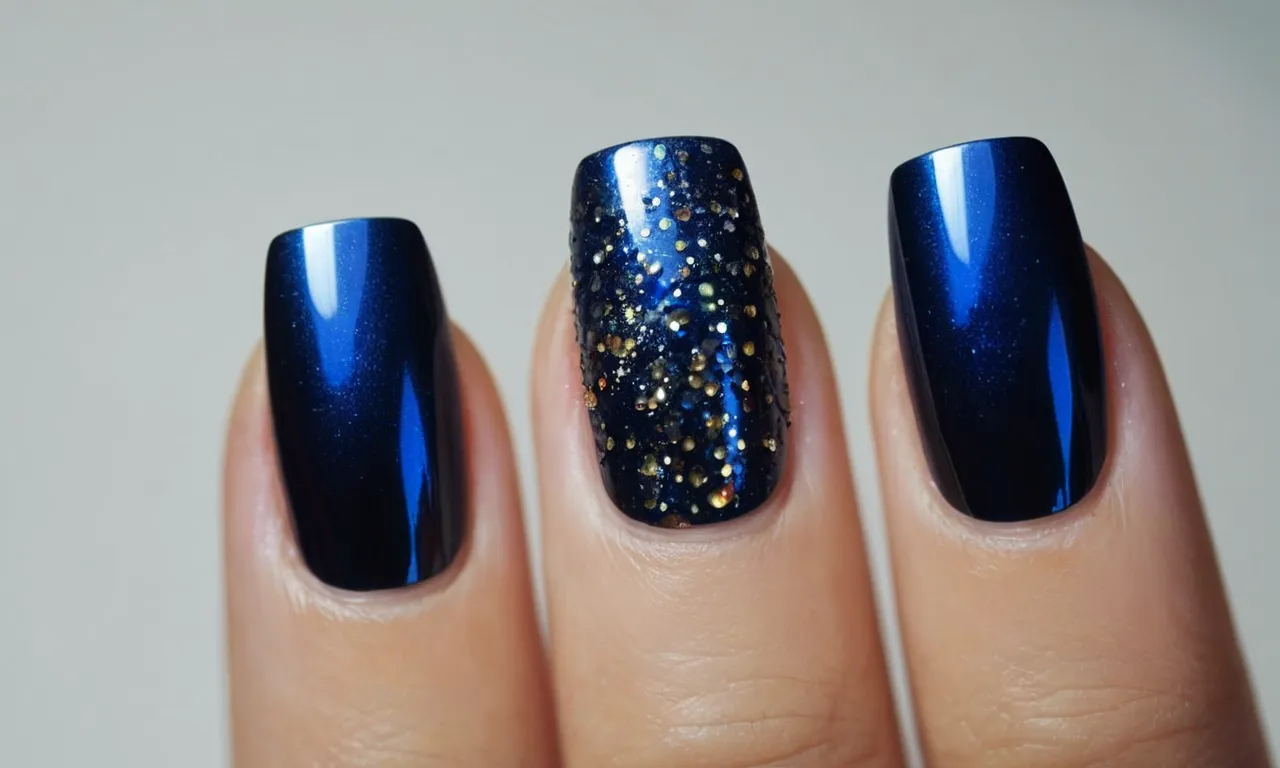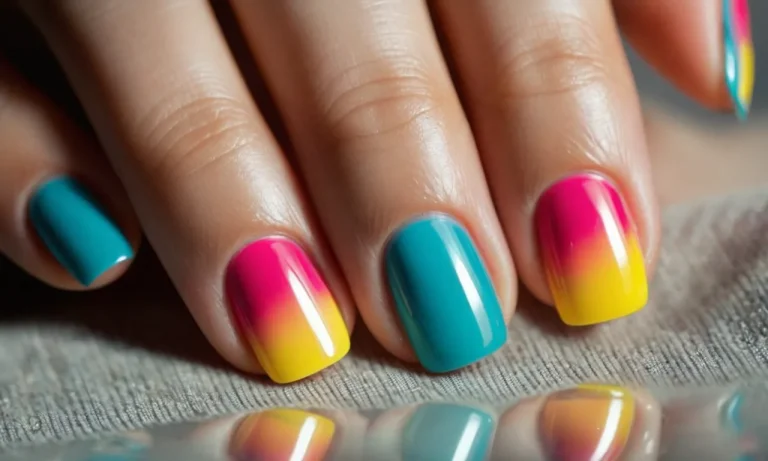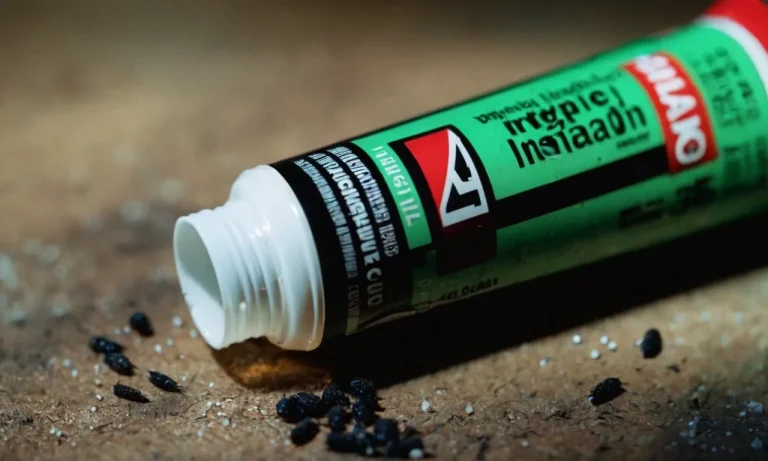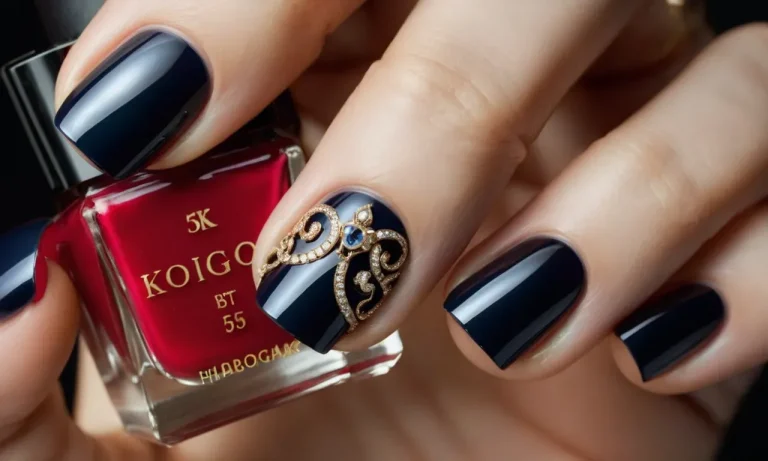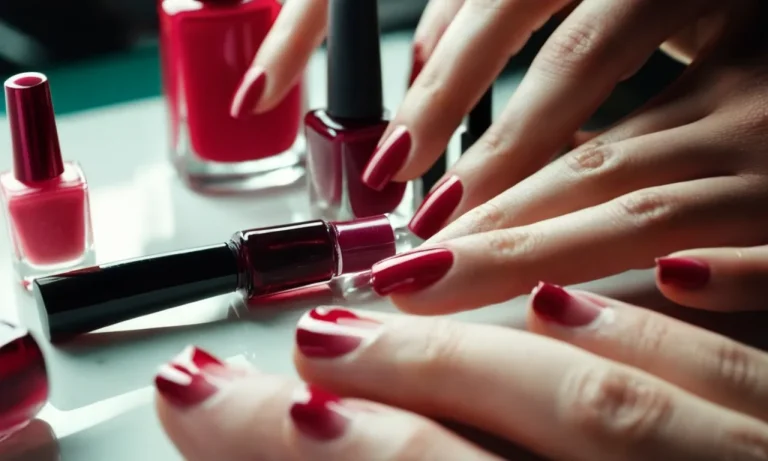Can Your Nails Grow Under Glue On Nails?
If you’ve gotten acrylic or glue on nails before, you may be wondering if your natural nails continue growing underneath the artificial ones. This is a common question for people new to these nail enhancement techniques.
The short answer is yes, your natural nails do continue to grow under glued on artificial nails. However, there’s more to it than that simple explanation. Read on as we dive into the details surrounding nail growth under artificial nails.
In this approximately 3000 word article, we’ll explore topics like how nails grow, whether different types of artificial nails allow growth, what happens as your nails grow, tips for allowing growth, and risks associated with growth under artificial nails.
We’ll also bust some common myths about nail growth under enhancements. Let’s get started!
How Do Nails Grow?
Nail growth is a complex process that involves several parts of the nail working together. Here’s an overview of how nails grow and what factors influence their growth rate.
The Parts of the Nail
Human nails are made up of the nail plate, nail bed, nail matrix, cuticle, lunula, and nail root.
- The nail plate is the hard, translucent part of the nail that we see.
- The nail bed is the skin underneath the nail plate.
- The nail matrix is the part of the nail bed that contains cells that produce new nail plate cells.
- The cuticle is the thin layer of dead skin at the base and sides of the nail plate.
- The lunula is the whitish crescent shape near the base of the nail.
- The nail root is where nail growth originates.
The Nail Growth Process
Nails grow from the nail matrix. The nail matrix contains finger-like projections called matrix germinal cells that produce new nail plate cells. As new nail plate cells are produced, older nail plate cells are pushed forward, and the nail grows.
This process is what makes nails lengthen from the nail root to the tip of your finger or toe.
It takes about 6 months for a fingernail and 12-18 months for a toenail to grow from the nail root to the tip. Toenails grow slower than fingernails.
Nail Growth Rate and Factors That Influence It
The average growth rate for nails is about 0.1 mm per day. That’s about 3-4 mm per month. However, nail growth can vary quite a bit from person to person and even between different fingers and toes.
Here are some of the factors that influence nail growth rate:
- Age – Nails grow fastest in youth and teenage years, slowing down as we age.
- Season – Some research shows nails grow faster in summer.
- Pregnancy – Hormone changes during pregnancy often speed up nail growth.
- Nutrition – Adequate protein, vitamins, and minerals promote faster growth.
- Trauma – Injury to the nail or finger/toe can temporarily slow growth.
- Health conditions – Illnesses like hypothyroidism may cause slower growth.
- Medications – Some medicines like retinoids for acne can affect growth.
While nails do continue to grow under nail polish, glues, gels, and acrylics used in manicures, they may seem to grow slower or get thinner. Frequent manicures and removal processes can damage the nail plate and temporarily disrupt normal growth.
Do Nails Grow Under Acrylics?
Yes, nails do continue to grow under acrylic nails. Acrylic nail application involves adhering artificial nail tips or extensions to the natural nail using an acrylic polymer powder and liquid monomer. This forms a hard protective layer over the natural nail that allows nails to grow underneath.
How Acrylic Nails Are Applied
Acrylic nails are applied using the following steps:
- The natural nail is filed and shaped.
- The nail is cleaned with primer.
- Nail tips are glued on or acrylic powder is applied over nail forms.
- Acrylic powder and liquid monomer are mixed and applied over the nail.
- The acrylic is shaped and smoothed into the desired nail style.
This process essentially encapsulates the natural nail under a hard, molded acrylic cover. The acrylic becomes tightly bonded to the nail, allowing the natural nail to grow safely underneath the false nail.
Growth Process Under Acrylics
With acrylic nails, the nail growth originates from the matrix under the cuticle. As new keratin cells form in the matrix, the nail plate grows forward, pushing out the tip of the nail.
The average growth rate for natural fingernails is about 3-5mm per month. This growth rate remains the same with acrylic nails. However, as the natural nail grows, the gap between the cuticle and acrylic nail becomes more apparent. This is known as nail growth lifting.
To maintain the acrylic nails, it’s recommended to get fills every 2-3 weeks. This involves:
- Filing under the acrylic to remove any lifted or loose areas.
- Reapplying acrylic polymer and monomer to bond the regrowth back to the original nail.
- Shaping and smoothing the nails.
Frequent fills prevent excessive lifting or cracking. If too much of a gap forms, water and debris can get trapped under the nail tip, leading to infections.
Do Nails Grow Under UV or LED Gel Polish?
How Gel Polish Is Applied
Gel polish has become an extremely popular nail service in recent years. Unlike regular nail polish, gel polish is cured under an LED or UV light, which allows it to harden on the nail. Gel polish typically lasts 2-3 weeks without chipping or peeling, making it a convenient and long-lasting manicure option.
Here’s a quick overview of how gel manicures are done:
- The nails are filed and shaped.
- The nails are cleaned to remove any oil or residue.
- A gel primer may be applied to help the gel adhere to the nails.
- Color gel polish is painted onto the nails in thin, even coats.
- Each coat is cured under the LED or UV light for 30-60 seconds to harden.
- Two or more coats are applied to get the desired color opacity and finish.
- A gel top coat is applied to seal and protect the manicure.
- The top coat is cured to seal and harden the polish.
Growth With Gel Polish
Now that we understand the gel application process, let’s discuss whether nails can grow under cured gel polish. The short answer is yes – nails absolutely do continue to grow as normal even when covered in gel polish. Here’s a more in-depth look at how nail growth occurs:
Nails grow from the nail matrix – the part of the nail under the cuticle and skin behind the nail. New nail cells are produced in the matrix and push out toward the nail tip, causing forward growth. Gel polish is only applied to the visible part of the nail plate.
It does not block the nail matrix or affect nail cell production and growth.
The gel remains flexible – Although gel hardens under the light, it retains some flexibility rather than becoming brittle. This allows the gel to flex as the nail grows without cracking or popping off.
It is common to see a small gap at the cuticle area as the new nail growth pushes the gel polish forward.
Growth rate remains unchanged – Research shows that gel polish does not alter the underlying nail growth rate, which averages 0.1 mm per day. Just like bare nails, gels will grow at a normal pace determined by genetics, health, and age.Gels must be filled every 2-4 weeks – As nails grow out, the gap at the cuticle becomes more apparent. Gel polish must be reapplied every 2-4 weeks to fill in new growth and avoid lifting or cracking as the nails lengthen. Frequent fills maintain the look and integrity of the gel manicure.
Do Nails Grow Under Nail Tips and Glue-On Extensions?
When nail tips or glue-on extensions are applied properly, they do allow nails to continue growing underneath. However, the nail growth may be slightly slower and more restricted compared to natural nail growth without enhancements. Here’s an overview of how nail growth occurs with tips and glue-ons:
Application of Nail Tips and Glue-Ons
Nail tips are made of lightweight plastic and shaped to fit over the natural nail. They are attached using nail glue or acrylic. Glue-on extensions are made from silk, fiberglass, acrylic, or gel and adhere to the natural nail with glue.
Both provide length and structure beyond the free edge of the natural nail.
During application, the natural nail is filed down lightly to create a rough surface for better adhesion. The nail tip or glue-on extension is sized to fit the nail bed and free edge, then bonded into place with adhesive.
The seam between the natural nail and the artificial enhancement is sealed with glue or acrylic for a seamless look.
Growth Process Under Glue-On Extensions
As long as the enhancements are applied properly without damage to the nail matrix (the part of the nail bed that stimulates growth), nails will continue to grow underneath glue-on tips and extensions. Here’s what happens:
- The nail plate grows from the matrix under the cuticle, passing through the nail bed until it reaches the free edge.
- With tips and glue-ons adhered to the nail plate, some downward pressure is placed on the nail bed. This may slightly slow nail growth.
- The nail will grow forward and push the enhancement forward as it extends.
- Growth usually continues at a rate of 3-5mm per month, on average, for healthy nails.
One study measured natural nail growth rates under extensions and found nails grew 3.6mm in four weeks under enhancements vs. 3.9mm growth without them. So extensions allow nail growth, though potentially at a bit slower rate.
As the natural nail grows out, the gap between it and the inside edge of the enhancement becomes larger. This is known as nail “lift.” Frequent fills are needed to re-adhere the lifted gap and prevent detachment or water getting underneath.
During fills, the natural nail can be trimmed and filed to fit properly against the enhancement again. Over time, the extensions are replaced once they grow too far beyond the free edge of the natural nail.
With proper maintenance and removal, nail tips and glue-ons allow nails to safely grow underneath them.
What Happens as Nails Grow Under Artificial Nails?
Appearance and Feel
As your natural nails grow underneath gel, acrylics, or other artificial nail enhancements, you may start to notice some changes in how they look and feel (source). The enhancements can start to lift away from the nail bed, causing air pockets and gaps.
This can lead to a gritty texture and pressure on the natural nail. The nails themselves may start to feel tighter underneath the artificial material. In some cases, you might see a visible white line between the artificial nail tip and your emerging natural nail.
Lifting of Enhancements
Over time, the seal between your natural nail and the artificial enhancement weakens as your nails grow (source). This leads to lifting around the edges and sides. As more of your natural nail emerges, the enhancement can start to lift further.
If left alone too long, the bond will eventually fail and the enhancement can pop off. This is especially true with nail tips, which have an obvious seam between the artificial tip and natural nail underneath. Getting timely fill appointments is key to preventing excessive lifting issues.
When to Get a Fill or Rebalance
As a general rule, you’ll want to get an artificial nail fill every 2-3 weeks (source). This maintains the bond and prevents excessive growth and lifting issues. Here are some signs it’s time for a fill appointment:
- You see a visible gap between the artificial nail tip and emerging natural nail
- The edges are starting to lift away from the nail bed
- You feel air pockets or texture under the artificial nails
- Pressure and discomfort under the enhancements
- The artificial nails look thicker or duller
Getting timely refill appointments helps maintains the health of your natural nails under the enhancements. This prevents excessive lifting and rebalances the extensions as your natural nails grow out.
Tips for Allowing Nail Growth Under Enhancements
Start With Healthy Nails
Having a good foundation is key for allowing your natural nails to grow under gel or acrylic overlays. Before your appointment, examine your nails to make sure they are free from infections, damage or excessive brittleness. Trim and file them into the desired shape.
Start with short, sturdy natural nails for the best chance of growth. Moisturize and nourish them daily with cuticle oil, rich creams or homemade treatments like olive oil soaks. This helps strengthen nails and cuticles for maximum growth potential.
Use Proper Application and Removal Techniques
Ask your technician to apply overlays as thin as possible, using forms to prevent pressure on the natural nail plate. Minimal filing of the natural nail is best. For removal, chemical soaks or acetone wraps are gentler than excessive filing or drilling, which can damage nails.
Watch closely during the process to ensure your natural nails remain intact. Taking these precautions will allow your nails to grow out healthier under enhancements.
Take Breaks Between Sets
Continuously wearing gel polish or acrylics for months on end can slow and weaken nail growth over time. Take a break of 2-4 weeks between sets to allow your natural nails to breathe and renew themselves. Trim and buff them into shape, use strengthening treatments, then apply a natural nail polish.
Giving your nails some overlay-free time periodically helps maintain growth.
Moisturize and Massage
Just like caring for your natural nails pre-application, nurturing cuticles and nails between infills is important. Daily cuticle oil around the nail edges maintains pliability for expansion as your nail grows. Lightly massage oil into the nail plate in the direction of growth.
A weekly hydrating soak refreshes and revitalizes nails under enhancements. This stimulation keeps them growing steadily forward.
Avoid Picking and Peeling
Resist the urge to pick at or peel lifted edges of gels or acrylics, which can pull up layers of the natural nail. This can impede growth and thin the nail plate over time. Instead, keep free edges sealed with topcoat or gel polish between appointments.
If lifting occurs, fill the gap temporarily with adhesive. Preventing moisture penetration and physical stress helps nails continue growing underneath.
Risks Associated With Nail Growth Under Artificial Nails
Increased Risk of Infection
Wearing artificial nails, especially for extended periods, comes with an increased risk of nail infections. Bacteria and fungi can more easily get trapped under the artificial extensions. The dark, moist environment under the false nails is a breeding ground for microbes (American Academy of Dermatology).
If the instruments used to apply artificial nails are not properly sterilized, infections can be introduced. Unsterile cuticle cutting can open the skin to bacteria. Continuing to get artificial nail services with unsterilized tools multiplies infection risks.
The infections often require oral antifungal or antibiotic medications to clear up.
Damage to the Nail Plate
Gluing artificial nails onto the natural nail plate can damage it. The glues and acrylics contain chemicals that break down the nail keratin structure. Soaking the nails in acetone to remove the artificial extensions also dries out natural nails. This makes the nails fragile and thin over time.
If artificial nails are tightened too much onto the nail plate, pressure can distort nail growth and hinder circulation. Attempting to remove too-tight acrylic or gel nails can rip off layers of the natural nail. This can be very painful and leave lasting irregularities in the nail plate.
Slowed Growth
Having a durable artificial layer adhered over natural nails slows their growth. The nail plate grows from the area under the cuticle, which gets mostly covered up by acrylic/gel tips. A study in the Journal of Cosmetic Dermatology (Gavazzoni Dias 2015) found a 28-40% decrease in nail growth rate with acrylic nails.
When the seal between the natural and artificial nail is compromised, moisture can seep under and create an environment for microbes to grow (raising infection risks). Frequent artificial nail replacement is often needed to prevent this lifted edge, which also repeatedly exposes nails to damage from filing and products.
Myths About Nail Growth Under Artificial Nails
Myth: Acrylic and Gel Stops Growth Completely
A common myth is that getting acrylics or gel manicures stops nail growth completely. While artificial nails can slow growth, they don’t halt it. Nails are made of keratin and grow from the nail matrix under the cuticle.
As long as the nail matrix remains undamaged, nails will continue growing at some rate.
One study found nails grow around 3-4 times slower with acrylic or gel nails compared to natural nails. So growth continues, just at a reduced speed. How much depends on proper application and removal to avoid damage.
Myth: Glues and Gels Ruin Nails Forever
Another misconception is that glues and gels used with artificial nails will irreparably damage the natural nails. With proper removal and care, natural nails can recover from acrylic and gel manicure use.
However, picking or peeling gels or acrylics off can pull layers of natural nails off too, leading to thinning and weakness. Gentle filing and acetone soaking minimizes damage during removal. Skipping manicures for a few months allows nails to regrow thicker.
One tip is applying a moisturizing oil like jojoba or vitamin E oil helps condition nails and cuticles after artificial nail use.
Myth: Artificial Nails Always Damage Nails
While getting artificial nails does carry risks to nail health, following best practices minimizes damage.
Using proper safe nail products certified by Artificial Nail Manufacturers (ANMC), going to a reputable nail salon, and caring for nails and cuticles helps maintain nail health with acrylic/gel manicure use.
One recent survey found over 80% of people had no or minor nail problems after professional application and removal within 8 weeks. So artificial nails don’t necessarily spell disaster for your nails with careful use.
Conclusion
Now you know the details when it comes to whether your natural nails can grow under enhancements like acrylics, gels, and glue on nails. While growth is definitely still occurring under those artificial layers, there are some risks involved if proper care isn’t taken and techs aren’t highly trained.
Work with your nail care provider to allow as much growth as possible while minimizing damage. And as always, give your natural nails a break in between sets when you can.
To summarize – yes, your nails do continue growing under glue on artificial nails! But growth may be slower and you need to take precautions to keep nails healthy under enhancements. We covered everything you need to know about the nail growth process with tips, risks, and myths along the way.
Hopefully you now feel informed on this common nail enhancement question.

